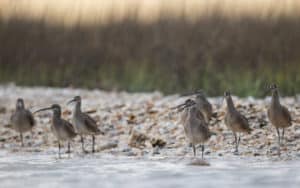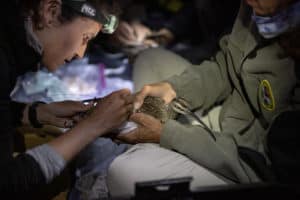Share this article
Watch: For a declining shorebird, a South Carolina island is a crucial refuge
Early one morning in the spring of 2014, Felicia Sanders, a biologist with the South Carolina Department of Natural Resources, was out on Deveaux Bank, a small island 20 miles south of Charleston, when she saw a surprising sight. Thousands of whimbrels were preparing to take flight after spending the night there. The shorebirds, which spend their summers in sub-Arctic regions of Canada and Alaska, seemed to be using the spot as a resting place during their migratory stopover from South America. That could be particularly important, since their numbers have been steeply declining.
Over the following years, she continued to notice them spending spring nights there. But trying to put together a team to do a comprehensive survey proved difficult. During the day, the whimbrels (Numenius phaeopus) disperse to forage. The only way to accurately count them was when they came back at night to roost.
“It took detailed planning to coordinate teams of counters to help survey this critical nocturnal roost,” said Maina Handmaker, a graduate student at the University of Carolina, who became interested in Sanders’s discovery.
In 2019, Handmaker worked with Felicia Sanders and her team of SCDNR biologists, volunteers and other collaborators to conduct the first systematic survey of the whimbrels, estimating how many were using the site during their stopover in South Carolina. The count is particularly important because of the birds’ declining numbers. In the past 25 years, whimbrels have declined by two-thirds across the Atlantic Flyway.

At high tides, and before dusk, whimbrel gather on elevated oyster shell bars on the edge of the North Edisto River. From here, they’ll depart to Deveaux Bank to roost for the night. Matt Aeberhard/Cornell Lab of Ornithology
Using the light of the moon, the surveyors were stationed at particular sites across Deveaux Bank to try to count the birds in 2019 and again in 2020. What they found surprised them. About 20,000 birds—roughly half the entire eastern whimbrel population—were using the island at night, according to their findings published recently in Wader Study.
“We really emphasize that the numbers we present are minimum counts,” Handmaker said. Because of the difficulty of counting at night, often relying on a full moon, getting complete counts has been hard.
The fact that the birds are using this area is important for conservation, Handmaker said. But it also leads to more questions. Researchers now know the birds sleep on the island, but where do they forage during the day? “If there wasn’t sufficient habitat close enough to Deveaux Bank, they wouldn’t be roosting there at night,” she said. “What we need to find out is how does proximity to Deveaux Bank influence how whimbrel choose foraging habitat?”

Maina handmaker (left) and Felicia Sanders affix a GPS transmitter to the back of a whimbrel during a late night trapping effort on an offshore sandbar at Deveaux Bank. Credit: Andy Johnson/Cornell Lab of Ornithology
Handmaker is now leading research investigating that question by putting GPS transmitters on the shorebirds. Meanwhile, they are working to nominate Deveaux Bank as part of the Western Hemisphere Shorebird Reserve Network to keep the landscape untouched. The protected salt marsh around Deveaux Bank provides foraging areas for the whimbrels.
“Nearly half a million acres of salt marsh and a lot of protected areas really speaks highly of South Carolina’s legacy of keeping these areas untouched and available to wildlife,” she said. “This to us is a hopeful story, because we have a chance to make sure the story of the whimbrel doesn’t end in extinction like so many species before.”
Header Image: Whimbrel flocks arrive over Deveaux Bank to roost at night, with large numbers pouring in after dark. Credit: Andy Johnson/Cornell Lab of Ornithology








